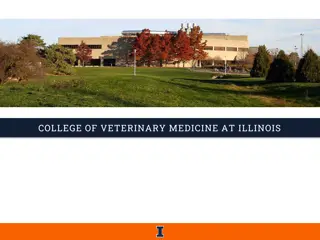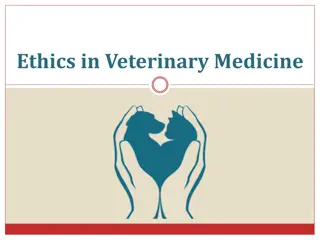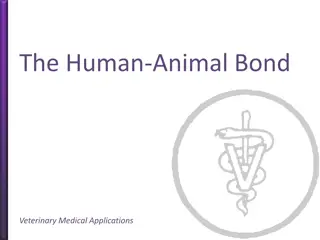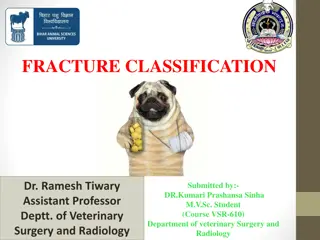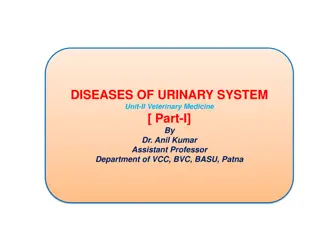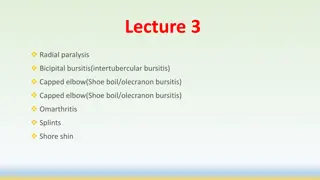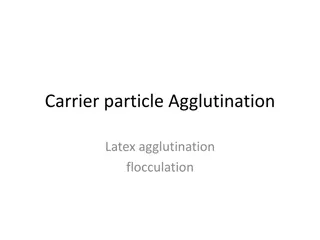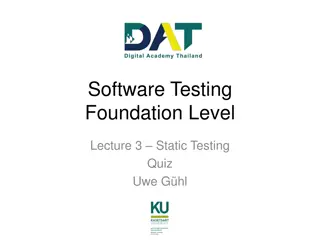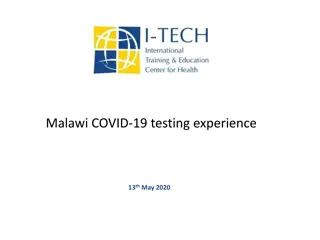Understanding Tuberculin Testing in Veterinary Medicine
Tuberculin tests have been vital in diagnosing latent and active tuberculosis in animals for over a century. Different methodologies and types of tuberculin, including avian and bovine, serve to differentiate between various forms of the disease. Procedures like the Single Intradermal Test (SID) are crucial in accurately measuring delayed hypersensitivity reactions. Proper injection sites and techniques are detailed to ensure accurate test results.
Download Presentation

Please find below an Image/Link to download the presentation.
The content on the website is provided AS IS for your information and personal use only. It may not be sold, licensed, or shared on other websites without obtaining consent from the author. Download presentation by click this link. If you encounter any issues during the download, it is possible that the publisher has removed the file from their server.
E N D
Presentation Transcript
TUBERCULIN TEST VCP-II Dr. Anil Kumar Asst. Professor Dept. of VCC, BVC
TUBERCULIN TESTS Used for ante-mortem diagnosis of latent and active TB in man and animals for more than 100 years. It is the PPDs that reveal a delayed hypersensitivity in a previous infected animal when they are intradermally inoculated Finland was the first country in the late 1890s to start a bovine TB eradication campaign using the tuberculin test TB program- based on a test and slaughter policy Different methodologies of the tuberculin test: ophthalmic and palpebral test, Stormont test, vulval test, etc. Neck is the suitable site of tuberculin injection The SIT test measures the cell-mediated delayed type hypersensitivity against bovine PPD injected in the mid-cervical region
Avian tuberculin: Made from Mycobacterium avium, and infects birds Used alongside bovine tuberculin to distinguish between cattle infected with M. bovis and those which react to other environmental mycobacteria Bovine tuberculin: Made from M. bovis. Triggers an immune response in cattle infected with M. bovis or similar Mycobacteria. Contains specific antigens (molecules which trigger an immune response) not present in environmental mycobacteria. Cattle that have bovine TB tend to show a greater reaction to bovine tuberculin than avian tuberculin
There are 4 methods to perform tuberculin testing: Single intradermal test (SID) Stormont test Short thermaltest Comparative test Requirements : Bovine tuberculin (PPD), sterile tuberculin syringe, 26 gauge needle, spring caliper, razor, 70 % alcohol, face mask, gloves and cap etc. PPD of bovine tuberculin: Prepared from M. bovis strain AN 5, contains 1 mg PPD per ml equivalent to 2000 Tuberculin Units (TU) per 0.1 ml and preserved with 0.5% phenol Single intradermal test (SID): The sensitivity of tests depends on the sites (neck region, anal, caudal fold at the tail base or vulvar lip) of injection At about the middle third of neck approximately mid way between upper and lower edge, the skin should shave 2 x 2 inch area and disinfest with 70 % alcohol
Pinch up a fold of the shaved skin of neck region and measure its thickness by Varnier / Spring caliper and record the reading Then, hold the skin fold firmly between the thumb and fore finger of the left hand and insert into it the needle (26 or 27 gauge and 1.25 cm long) of the tuberculin syringe containing 0.1 ml of tuberculin The depth to which the needle is inserted into the skin is of great importance and vary with the thickness of the skin The reaction produced will be marked in dermis than epidermis after injection A small pea-like swelling in each site should be palpated after injection to confirm the correct intradermal injection Measure the thickness of the skin fold 72 hours after the injection Interpretation: Palpate the sites and note the presence or absence of warmth, tenderness and consistency of swelling An increase in skin thickness 4 mm or more is considered positive.
The animals that are not infected by the disease usually no change in thickness Sometimes, a small swelling is produced, but the increase in skin thickness does not usually exceed a few millimeters and also no local heat and tenderness The most characteristic feature of a positive reaction is the presence of diffuse oedema. Demerits of SID: Lack of specificity (probability that an uninfected animal is correctly identified)because of presence of non visible lesion reactors. It is due to the sensitization of animals with other harmless Mycobacterium spp. Nocardia farcinicus causing farcy in bovines sensitize animals to this test. Failure to detect cases of minimal sensitivity, viz. in early stages of disease, in advanced stages of disease, in recently parturated and in old animals. Mammalian tuberculin is not specific to differentiate infection with M. bovis, M. avium, M. tuberculosis and M. avium paratuberculosis.
Stormont test: Devised to detect the poorly sensitized cases. Procedure is same as single I/D test. In this test second dose of tuberculin is injected at the same site (same dose and route) seven days after first injection. After 24 hours of 2nd injection, examine the area. If it is hot, painful, swollen and increase in thickness of 5 mm or more, then reaction is considered positive for tuberculosis. The increased sensitivity to Stormont test is thought to be due to attraction of T-cells to the site by the first injection. The increased sensitivity begins at day 5th, reaches its peak on 7th day and ends on 12th day post injection. Disadvantage --three visits are required to perform this test.
Short thermaltest: 4 ml of dilute tuberculin is injected subcutaneously in neck area of cattle with rectal temperature not more than 39OC or 102OF at the time of injection and for 2 hours later. The temperature is again noted at 4, 6 and 8 hours after injection. If temperature rises above 40OC or 104OF within this time period, then reaction is considered positive for tuberculosis. In infected animals the temperature peak usually occurs between 6-8 hours and is generally 41OC. Test is able to detect advanced cases of disease. Highly efficient test to detect spreader case(s) giving negative reaction to SID. Sometimes there may be death due to anaphylactic reaction
Comparative test: Procedure is same as single I/D test. In this test avian and mammalian tuberculin are injected simultaneously 12 cm apart on the same side of neck area one above the other. Test is read after 72 hours. Greater of two reactions will indicate organism responsible for causing sensitization. This test is not meant for primary screening but only to follow a non- reactor to determine organism. The recently developed interferon- assay used on blood lymphocytes stimulated with M. bovis antigen shows promise as an alternative to the widely used SID test. infecting





